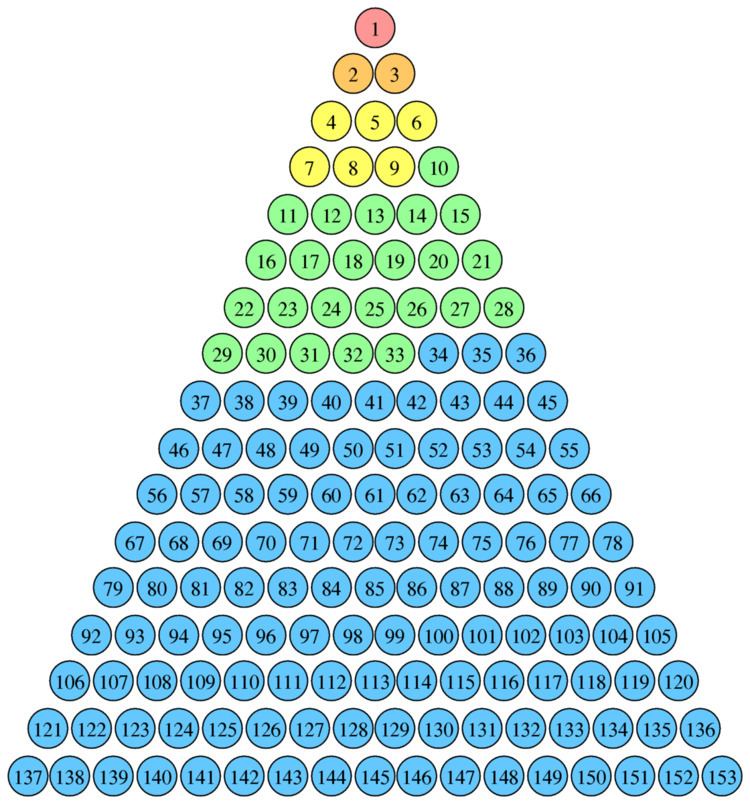153 154 → Divisors 1, 3, 9, 17, 51, 153 | Factorization 3× 17 Roman numeral CLIII | |
 | ||
Cardinal one hundred fifty-three Ordinal 153rd(one hundred and fifty-third) | ||
153 (one hundred [and] fifty-three) is the natural number following 152 and preceding 154.
Contents
Mathematical properties
The number 153 has several interesting mathematical properties. 153 is the sum of the first 17 integers and is also the sum of the first five positive factorials, 1! + 2! + 3! + 4! + 5!. The number 153 is associated with the geometric shape known as the Vesica Piscis or Mandorla. Archimedes, in his Measurement of a Circle, referred to this ratio (153/265), as constituting the "measure of the fish", this ratio being an imperfect representation of 1/√3.
As a triangular number, 153 is the sum of the first 17 integers, and is also the sum of the first five positive factorials:
The number 153 is also a hexagonal number, and a truncated triangle number, meaning that 1, 15, and 153 are all triangle numbers.
The distinct prime factors of 153 add up to 20, and so do the ones of 154, hence the two form a Ruth-Aaron pair.
Since
The Biggs–Smith graph is a symmetric graph with 153 edges, all equivalent.
Another interesting feature of the number 153 is that it is the limit of the following algorithm:
- Take a random positive integer, divisible by three.
- Split that number into its base 10 digits.
- Take the sum of their cubes.
- Go back to the second step.
An example, starting with the number 84:
In the Bible
The Gospel of John (chapter 21:1–14) includes the narrative of the miraculous catch of 153 fish as the third appearance of Jesus after his resurrection.
The precision of the number of fish in this narrative has long been considered peculiar, and many scholars, throughout history, have argued that 153 has some deeper significance. Jerome, for example, wrote that Oppian's Halieutica listed 153 species of fish, although this could not have been the intended meaning of the Gospel writer because Oppian composed Halieutica after the Gospel text was written, and at any rate never gave a list of fish species that clearly adds up to 153. It has also been noted that the Tetragrammaton occurs 153 times in the Book of Genesis.
Augustine of Hippo argued that the significance lay in the fact that 153 is the sum of the first 17 integers (i.e. 153 is the 17th triangular number), with 17 representing the combination of divine grace (the 7 gifts of the Spirit) and law (the Ten Commandments). Theologian D. A. Carson discusses this and other interpretations and concludes that "If the Evangelist has some symbolism in mind connected with the number 153, he has hidden it well," while other scholars note "No symbolic significance for the number of 153 fish in John 21:11 has received widespread support."
Writers claiming a major role for Mary Magdalene have noted that in Greek isopsephy her epithet "η Μαγδαληνή" bears the number 8 + 40 + 1 + 3 + 4 + 1 + 30 + 8 + 50 + 8 = 153, thus, it is suggested, revealing her importance. Similarly, the phrase "τὸ δίκτυον" (the net) used in the passage bears the number 1224 = 8 × 153, as do some other phrases. The significance of this is unclear, given that Koine Greek provides a choice of several noun endings with different isopsephy values. The number 153 has also been related to the vesica piscis, with the claim that Archimedes used 153 as a "shorthand or abbreviation" for the square root of 3 in his On the Measurement of the Circle. However, examination of that work does not find the number 153 used in that way.
Although, John R. Hellmann gives solid argumentation that the number 153 was used by John as a metaphor to allude to the wisdom of Archimedes. The misleading reason that the number 153 does not look prominent in a modern discussion on Archimedes is because of the use of the relatively modern horizontal fraction bar.
However, the early Greeks wrote their fractions or ratios in linear form. They could not have used the horizontal fraction bar. The use of the horizontal fraction bar came much later. The horizontal fraction bar is first attested in the work of Al-Hassār in A.D. 12th Century.
See explanation at web site below of why in the time John's Gospel was written the number 153, as used in Archimedes work on Pi, was more obviously prominent.
See: http://www.defendingthebride.com/ss/fish/archimedes.html#arch
And, according to that position, John was able to gently imply that ALL wisdom comes from and through Jesus. By doing this, it is argued, John addressed the objection of the Greeks in a pastoral way.
See: http://www.defendingthebride.com/ss/fish/conclusion.html
Evagrius Ponticus referred to the catch of 153 fish, as well as to the mathematical properties of the number (153 = 100 + 28 + 25, with 100 a square number, 28 a triangular number and 25 a circular number) when describing his 153-chapter work on prayer. Louis de Montfort, in his fifth method of saying the Rosary, connects the catch of 153 fish with the number of Hail Marys said (3 plus 15 sets of 10), while St Paul's School in London was founded in 1512 by John Colet to teach 153 poor men's children, also in reference to the catch.
In the military
In transportation
In sports
In radio and TV
In other fields
153 is also:
